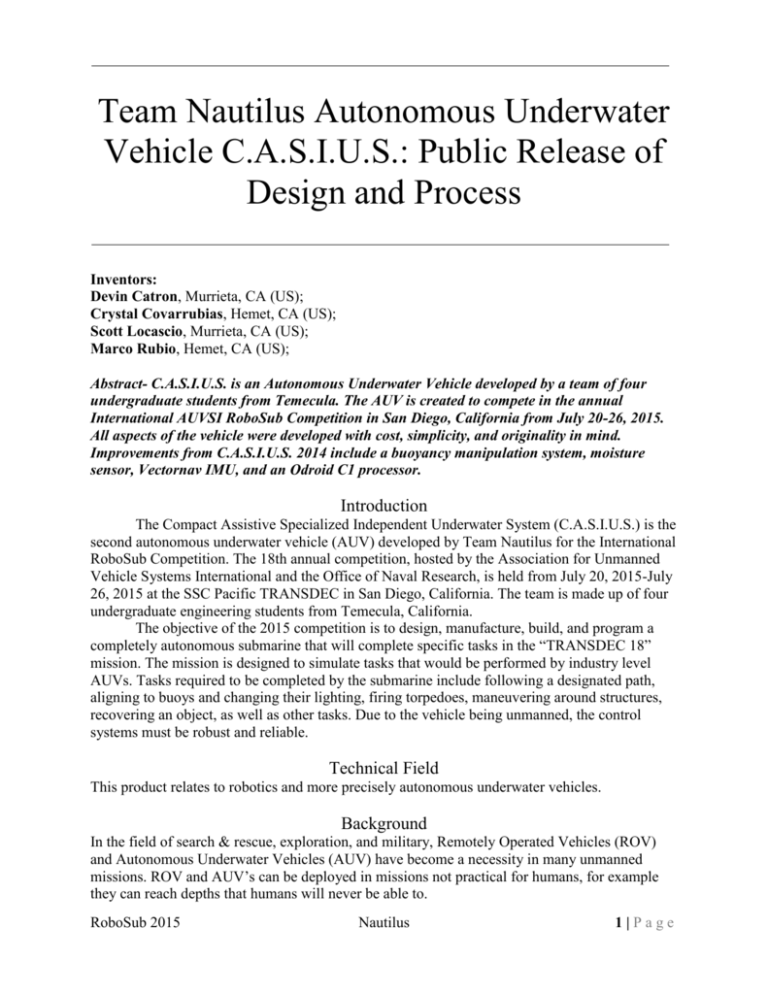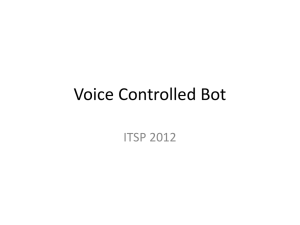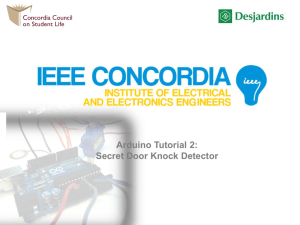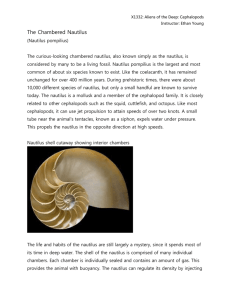Journal Paper
advertisement

Team Nautilus Autonomous Underwater Vehicle C.A.S.I.U.S.: Public Release of Design and Process Inventors: Devin Catron, Murrieta, CA (US); Crystal Covarrubias, Hemet, CA (US); Scott Locascio, Murrieta, CA (US); Marco Rubio, Hemet, CA (US); Abstract- C.A.S.I.U.S. is an Autonomous Underwater Vehicle developed by a team of four undergraduate students from Temecula. The AUV is created to compete in the annual International AUVSI RoboSub Competition in San Diego, California from July 20-26, 2015. All aspects of the vehicle were developed with cost, simplicity, and originality in mind. Improvements from C.A.S.I.U.S. 2014 include a buoyancy manipulation system, moisture sensor, Vectornav IMU, and an Odroid C1 processor. Introduction The Compact Assistive Specialized Independent Underwater System (C.A.S.I.U.S.) is the second autonomous underwater vehicle (AUV) developed by Team Nautilus for the International RoboSub Competition. The 18th annual competition, hosted by the Association for Unmanned Vehicle Systems International and the Office of Naval Research, is held from July 20, 2015-July 26, 2015 at the SSC Pacific TRANSDEC in San Diego, California. The team is made up of four undergraduate engineering students from Temecula, California. The objective of the 2015 competition is to design, manufacture, build, and program a completely autonomous submarine that will complete specific tasks in the “TRANSDEC 18” mission. The mission is designed to simulate tasks that would be performed by industry level AUVs. Tasks required to be completed by the submarine include following a designated path, aligning to buoys and changing their lighting, firing torpedoes, maneuvering around structures, recovering an object, as well as other tasks. Due to the vehicle being unmanned, the control systems must be robust and reliable. Technical Field This product relates to robotics and more precisely autonomous underwater vehicles. Background In the field of search & rescue, exploration, and military, Remotely Operated Vehicles (ROV) and Autonomous Underwater Vehicles (AUV) have become a necessity in many unmanned missions. ROV and AUV’s can be deployed in missions not practical for humans, for example they can reach depths that humans will never be able to. RoboSub 2015 Nautilus 1|Page I. Design This year’s vehicle was designed as an improvement over the last generation. Features include an omni-directional thrust pattern, a more compact motor control system and a buoyancy system. The drive system is not only distinctive, but also very maneuverable; allowing the vehicle to move in all directions, rotate on its central axis, strafe, and move diagonally. The motor control system supports two more motors than last year’s model yet is drastically smaller. The buoyancy system will allow us to control our buoyancy at various depths as to keep strain off our motors and power supply. The objective for C.A.S.I.U.S. was to design an AUV that would be practical in real world applications. Due to the nature of the competition and the need for unmanned vessels, Team Nautilus aimed to design a vehicle that would satisfy the needs of both civilian and military uses. II. Mechanical System C.A.S.I.U.S.’s mechanical system consists of the frame, motors, electronics enclosure, and buoyancy system. A. Frame The frame of C.A.S.I.U.S. is made of 1” boxed 6061 aircraft grade aluminum. The chassis was designed as straight forward as possible in order to keep weight, cost, and complexity to a minimum. Components are attached to the frame using clamp style, or quick connections to allow for hot swappable units. B. Motors The vehicle is propelled by eight 1100 gallon per hour (GPH) bilge pumps that were ‘hacked’ to become low cost, high output thrusters. These thrusters only cost $20.00 for the pump, prop, and prop adaptor. In order to achieve maximum maneuverability, four of the eight motors are attached to the corners of the frame each at a forty-five degree angle. The position the thrusters are angled creates a holonomic drive system that allows the submarine to effortlessly sway and surge. Two of the eight motors are placed on the front and back of the submarine for easy heaving motions.Each of the eight brushed motors is powered by twelve volts of direct current (DC). Under heavy load, each motor draws approximately two amperes of current per hour. C. Electronics Enclosure The electronics enclosure is a Pelican 1450 case mounted to a quick release system that is not only for ease of use, but allows the center of gravity (CG) to be lower. The interior dimensions of the Pelican Case are (LxWxD) 14.62”x 10.18”x 6” (37.1 x 25.8 x 15.2 cm). The exterior dimensions of the case are (LxWxD) 16" x 13" x 6.87" (40.6 x 33 x 17.4 cm). The small case is ideal because there is less of a need to compensate for buoyancy. Due to the transportability and accessibility factors of the vehicle, all of the items inside of the enclosure are secured in their tailored fit compartments. Each compartment is modular in order to easily modify any components when necessary. In order to relay information from the motor controllers placed on the inside of the enclosure to the motors located on the frame, waterproof connections were drilled to the top front of the Pelican case. Each connection has a designated purpose: 1. Motor controllers RoboSub 2015 Nautilus 2|Page 2. Tether 3. Cameras D. Buoyancy System This system is comprised of a large chamber of air that can be expanded or contracted as needed to control the buoyancy at different depths. The chamber is controlled by a plug which is moved forwards and backwards linearly to modify the density and surface area of the air pocket contained within. The plug is attached to a worm gear which is driven by a 5v DC stepper motor wired to the microcontroller. This system is attached to the top of the electronics enclosure. III. Electrical System C.A.S.I.U.S.’s electrical system provides the vehicle with run time power. A. Power The battery consists of one 12 volt, 18 ampere hour lead-acid. The battery weighs 15 pounds (6.8 kg) and allows the vehicle to have a low and centralized center of gravity. B. Microcontrollers Microcontrollers control many of the systems, including: movement, sensor feedback, datalogging, and diagnostics. The microcontrollers on C.A.S.I.U.S. are based off of the Arduino™ Mega platform. The open source platform provides availability, accessibility, and support, allowing easy implementation. C. Motor Controllers The motor controllers are designed to convert a digital PWM wave into smooth and continuous motor speeds. Pololu High-Power Motor Drivers are used to control the submarine’s motors, with a maximum input voltage of thirty volts direct current and a peak current of twentyone amps. The motor controllers have a maximum two milliseconds at 40kHz PWM signal and simple calibration, this combination results in ideal motor controllers for C.A.S.I.U.S.’s purposes. The compact size of these controllers makes for a much more spacious and organized design inside the electronics enclosure. D. Central Processing Unit The ODroid-C1 microprocessor was chosen as the central processing unit (CPU) for C.A.S.I.U.S. The microprocessor was chosen over a conventional system, such as a mini-ITX, because of the low power consumption and cost. Specifications include: 1 Gigabyte DDR3 RAM eMMC 4.5 HS200 flash storage slot Quad Core Cortex™-A5 processor with Dual Core Mali™-450 GPU Linux provides the submersible with a fast and minimalistic operating system. The ODroid runs on Ubuntu, a Linux based operating system (OS). IV. Sensors C.A.S.I.U.S.’s sensors include analog and digital, as well as visual. A. Cameras RoboSub 2015 Nautilus 3|Page C.A.S.I.U.S. is equipped with 3 HD Microsoft LifeCam Studio cameras. There are two in the front to act as stereoscopic vision and one in the back looking underneath the vessel. These cameras have 1080p vision with autofocus capabilities. B. Inertial Measurement Unit The purpose of the IMU is to keep the vehicle leveled and stable during its mission. The IMU is a VN-200 Rugged GPS/INS, donated by VectorNav. Based on the pitch and the roll, it is determined which motors are going to be in use. C. Depth Sensor The depth is regulated and logged by an AST20PT depth sensor. This sensor is capable of taking pressures up to 50,000 PSI. The sensor is analog and consists of a resistive diaphragm that changes voltage readouts as pressure increases or decreases. D. Moisture Sensor The purpose of the moisture sensor is to keep track of the overall humidity inside of the electronics vessel. The moisture sensor is controlled by an Atmel attiny84 microcontroller. This was used because of the low power consumption, size, and ease of use. The theory behind the sensor is that the probes on the bottom of the case would ‘short’ when submerged in water. This connection would then send a signal to a piezo element that would buzz for audible feedback. Making contact with the probes will send a signal that triggers a relay to send the vehicle into a complete shutdown, thusly preventing any electronic and water damage. E. Data Logging As a result of debugging problems that occurred on Nautilus I, C.A.S.I.U.S. contains a data logging system that allows seamless navigation through issues. The data logging system consists of an Arduino™ UNO and a SEEEDStudio SD card shield. The system logs everything from time and mission length to moisture levels. It records everything in a .csv file and can be opened in a standard spreadsheet program. VI. Software The software used for C.A.S.I.U.S. is a combination of Arduino™ C and Python. A. Visual Software The submersible navigates through obstacles with the use of detection via USB webcams. Using Open Source Computer Vision (OpenCV), in Python, the webcams are able to be programmed to detect user defined objects and shapes. Colors can be detected by using either red, green, blue (RGB) color spectrum or hue and saturation values (HSV). In order to widen the tolerance, a Gaussian blur is overlaid the frames, by doing so images are not as sharp but processing is much smoother. B. Movement System The movement system was developed in the Arduino™ Integrated Development Environment (IDE) using Arduino™ C as the primary language. This system is designed to react to readings relayed from the IMU to the Arduino™, then as outputs to the motors. RoboSub 2015 Nautilus 4|Page C. Sensors Sensory input output (IO) is controlled by microcontrollers based on the Arduino™Mega platform. Both analog and digital sensors are programmed in Arduino™ IDE using Arduino™ C. The analog sensors are read by interpreting voltage feedback and the digital sensors are programmed using Inter-Integrated Circuits (I C). 2 Acknowledgment Team Nautilus would like to thank all our supporters during our third year competing. We would like to thank Gears2Robots for allowing us to work in their Tech Academy and providing resources. We would also like to thank Re/Max Platinum Realty, Vectornav Technologies, Creative Data Solutions, and LINX Personal Manufacturing for their sponsorship. RoboSub 2015 Nautilus 5|Page










